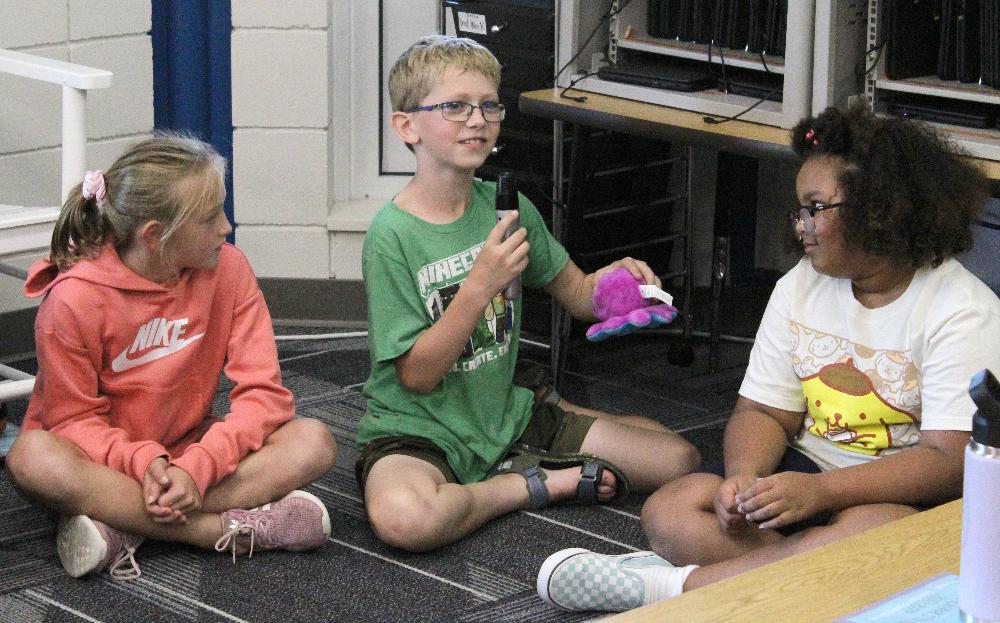Humann Elementary focuses on creating connections through restorative circles
September 5, 2023
Humans have associated circles with ideas of well-being, connection and restoration for thousands of years.
Humann Elementary School staff are using their own circle-based ideas to reach those same healthy goals.
Staff are beginning a school-wide implementation of restorative circles for the first time this school year. They are using them as a way to create positive connections and behavior in their classrooms.
Humann Principal Jamie Cook said restorative circles are a proactive approach to maintaining a healthy school environment. Teachers and administrators believe students will learn more and will feel and act better at school when they have good relationships with each other.
“Many of our teachers have found these circles to be highly effective in building a strong classroom community built on trust, transparency, vulnerability, respect, responsibility and safety,” Cook said.
Fourth-grade teacher Emily Pickerel has been one of the pioneers of circles at Humann. She took a restorative practices class in 2020 and began using the activity during the year of remote learning.
Pickerel teaches students about being safe, respectful and responsible during her circles - lessons that are not new to LPS students. During circles, she reinforces lessons in topics such as kindness, forgiveness, gratitude, inclusivity and being a good role model. These have been beneficial for everyone.
“The circles have helped build a classroom community among my scholars,” Pickerel said. “It helps them feel like they have a voice in our classroom. They have been successful in building relationships and making connections.
“A big takeaway from implementing circles is a decrease in problem behavior. The year I started using circles, I noticed a decrease in my office calls. Overall, I just love having a time of the day to connect with every single student and watch them learn more about their peers.”
Kindergarten teacher Allie Andersen said delivering lessons to young students about appropriate behavior and caring for others will help them as they grow older. Her students begin every morning by sitting on the floor and talking with each other.
“If we can instill empathy and caring in our scholars from an early age, it is more likely to carry on with them,” Andersen said. “In this dedicated circle time, we are able to really focus on these skills and practice what they do and do not look like. Practice is key.
“Just talking about it isn’t always enough. We talk through scenarios and think about what we would say or do, even act scenarios out at times. When scholars are then in these situations, they have some prior knowledge to dip back into to help them through. As they continue to practice these skills at a young age, it becomes second nature.”
Fifth-grade teacher Laura Heller has also seen positive outcomes with her older students.
“Restorative circles have been such a calming aspect of our week,” Heller said. “Even on week three, students know what to expect when we come to circle, and I can sense a feeling of calm in the room. There are students who are more hesitant to share ideas in other subject areas, but when we get in a circle, they are much more comfortable.
“Circles have helped them build connections and confidence in our classroom. It has also enhanced the community sense. Our classroom is everyone’s as opposed to just mine.”
Mattie Trejo-Amen introduced restorative circles in several classrooms in the spring semester of the 2022-23 year as part of her counseling work. The pilot program was an immediate success, and she made plans to expand the concept. Humann teachers attended training sessions during the spring and summer to prepare for the school-wide implementation.
“Students and teachers enjoy them and are excited about them!” Trejo-Amen said. “It provides students with a voice and opportunity to be heard and respected. Circles allow students and teachers to work with each other to build a strong community of learners.”
Restorative circles can also be used as one way to respond to unwanted behavior that has affected the classroom community. For example, if a teacher notices that students are talking when they are not supposed to during a math lesson, they can meet with the whole class.
The teacher can discuss the situation with everyone and can ask them if the out-of-turn talking has affected their learning. This helps all students see the impact of their actions, and they can then make sure everyone understands the classroom expectations moving forward.
Andersen’s students also learn skills like how to ask friends to play, how to ask permission for something and how to give and accept compliments. This can go a long way in preventing disagreements. When situations arise, students are able to refer back to what they talked about in their circles.
Andersen said restorative circles at Humann will lead to many moments of well-being throughout the year.
“This has been so great for the kids to get to know each other’s names and make connections to things they have in common with their fellow scholars, especially since a majority of the kindergarteners are new to Humann and don’t know each other already,” Andersen said. “I always give my kiddos an opportunity to pass when the ‘talking piece’ comes to them, but I don’t see that often. They love to share and make connections with each other!”
Do you have a story idea? Share it with the LPS Communications Team by filling out this form!
Published: September 5, 2023, Updated: September 9, 2023

A student in Emily Pickerel’s fourth-grade class smiles as he holds a microphone and “talking piece” during a restorative circle on Aug. 28. Humann Elementary School staff members are incorporating restorative circles into their lesson plans this year. Pickerel said the circles have benefited her students in many ways. They talk about topics such as kindness, forgiveness, gratitude, inclusivity and being a good role model.
